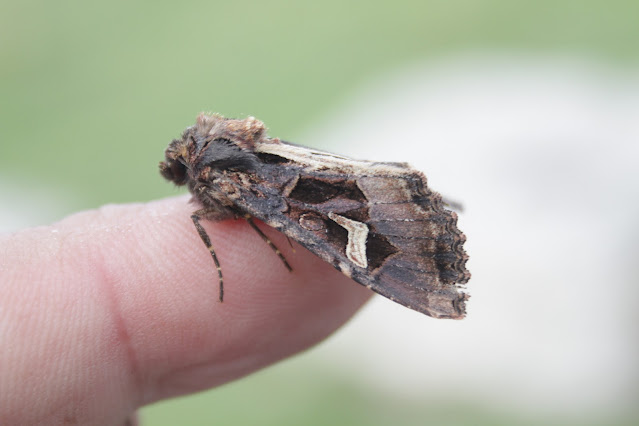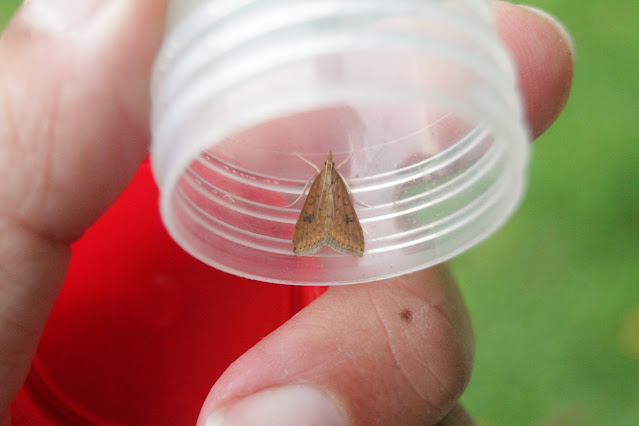After work on Wednesday I simply had to get down to the South Coast to try and connect with some of this epic moth migration that's been going on in this spell of southerlies (also brought in loads of Pallid Swifts across the UK). I overnighted at Kojak's on Wednesday night and then we headed down to Portland from Thursday to Saturday. On Thursday night I ran an MV in a coastal quarry east of Southwell and on Friday night a Heath trap from the Pulpit Inn. I got a few migrants but nothing that great but it was a different story back at the Observatory were Martin, Jodie and Co had up to 10 traps on the go. Highlights in photos below.
The birding was pretty good too (Ebird trip report
HERE). Did a bit of noc-mig from the campervan (just a few Redwings and Song Thrush).
In short we didn't find much ourselves (either birds or moths) apart from a Short-eared Owl and a wing-barred Phyllosc that was too distant and disappeared over the cliff with Long-tailed Tits before we could nail it so basically just did a load of fantastic island twitching.
Thanks again to Martin for all his help on this great little trip. Now back home in the migrant desert of Bucks praying for something to be blown all the way in land here. We've still got a few more days of these southerlies.
Pallas's Warbler in the obs car park- there were three on the island
Short Eared Owl over East Cliffs
Wryneck in the Obs quarry. In addition to the scarcer migrants we also had some nice vis-mig (mainly finches, pipits, Skylarks and Woodpigeons) and good numbers of Stonechat (we counted nearly 40), a single Wheatear, Barn Swallow, a few Bramblings, a Snipe, surprisingly few Redwing by day and only one Fieldfare, a couple of Firecrests, Merlin, still quite a few Chiffs around and a couple of Blackcap
Moth highlight was this Egyptian Bollworm (above and below)- the 11th for Britain and the 4th recorded at Portland. A resident of Africa, Asia and Australia and recorded in the Mediterranean. Some British records have been imports but other records in the south associated with influxes of migrant moths are suspected to be genuine migrants. Considering the location, the weather conditions and the association with a major moth migration event, this indeed is a prime suspect for a genuine migrant.


Crimson Speckled- Martin caught this while doing the net run in the fields (in his sock apparently lol). This species has never been caught in the light traps at Portland with all records there relating to individuals found in the field. There were 12 of these at Dungeness today and similarly none of them came to light so certainly one to look for by day. This species has been the 'cover-girl' of this period of migration (if I understand correctly this is a record influx) so it was great to catch up with one but a bit disappointing to not find one despite a lot of searching. (We also spent hours and hours looking for a Pallid Swift in vain. Thank goodness other people were having more luck than we had.) I did a search on this blog to see where I've seen Crimson Speckled before abroad and there was a reference to having seen them on Corvo in 2011 (we had two in the Lower Fields and I had only started looking at moths then so didn't have any context for them and I didn't record them anywhere officially as didn't know their local status) - I did a quick literature search this evening and it appears they might have been the first records for Corvo (I definitely haven't seen any there since, see postscript for photos) so with a bit of time travelling I did in a way find my own Crimson Speckleds today :-) Also while searching for the photos of the Corvo Crimson Speckleds I also found photos of a Spotted Flycatcher on Corvo and a first-winter Arctic Tern from Sao Miguel, two species I had totally forgotten I'd seen on the Azores and need to add them to my Azores list- so two new Azores ticks today too!- I found more rarities lurking in my computer in the last hour than I did in three days on Portland in super charged weather conditions.

Vagrant Metal-mark, Teberna micalis- another good one
Radford's Flame Shoulder- only one or two of these. This time last year I was here when Martin had 65 in the trap (Portland had over 600 last year in total). Radford's have been notably very scarce this year on Portland (maybe the establishing population got wiped out in this year's drought?).
Cosmopolitan- two or three of these. A lifer. In total I had 7 moth lifers so a mighty fine little trip.
Oak Rustic- a few of these too. Another lifer. Not a migrant I don't think as established in this area.
Scarce Bordered Straw- good numbers (probably 15 to 20 over the trip) of this rather variable moth, a dark/patterned one (above) and a paler/plainer one (below).
Small Mottled Willow- two or three of these too.
Palpita vitrealis- always nice to see and quite a few of them too
Diamond-back moth. Conspicuous by it's low keyness in not only this major influx but this whole year of moth migration. I only saw this one throughout the whole trip.
Vestal (above) and Crocidosema plebejana (below). In addition to these migrants and the migrants above we also had Delicates, Dark Sword Grass, Silver-Y, lots of Angle Shades, White-Points, Turnips, Rusty-dot Pearls and stacks of Rush Veneers (coming up at our feet while walking too).
A couple of Portland specialities- Flame Brocade (above) and Beautiful Gothic (below). Also lots of Feathered Ranunculus, a single Feathered Brindle and lots of White-specks.
A unseasonal presumed Shaded Pug (a lifer)
A Bloxworth Snout (another lifer on the bogey moth list). Another species that does not come to light at Portland but found during the day.
A presumed Tomato Leafminer, Tuta absoluta . An adventive moth, originally from South America has become a pest in Southern Europe. It flies later than other similar species, well into December.
A couple more shots of the Shortie
Another shot of the Pallas's showing it's best bit
Northern Wheatear
Up to 500 Gannets off the bill were impressive to watch feeding in the keen southerly wind
Portland
Postscript
Crimson Speckleds from Corvo October 2011- resurrected from the archive from when I had just started taking an interest in moths, as far as I know the first records for Corvo and only records away from Santa Maria (see Azores moth list
HERE ). By the sounds of it Crimson Speckleds are quite variable with the red markings sometimes forming cross bands and the black spots sometimes reduced to tiny specks (the two specimens above and below are clearly different,). The only other place I've come across Crimson Speckled is from their 'home' in North Africa (and the Med), so a species more at home with sand vipers etc, see
HERE . Particularly on Corvo there is also the similar American species, Beautiful Utetheisa,
Utethesia bella to look out for (recorded once in UK on Skokholm, 1948), which is like Crimson Speckled but has pink bands and blotches and also the hind wing has a pink tinge. If all goes to plan will hopefully be expanding the mothing effort on the Azores next year.


First-winter Arctic Tern on Sao Miguel in 2011. A retrospective Azores tick as I forgot we saw this- had just been watching a White-tailed Tropicbird. Also a Spotted Flycatcher photo lurking in the archive- another species I'd forgotten I'd seen on the Azores.

































.JPG)





















.JPG)